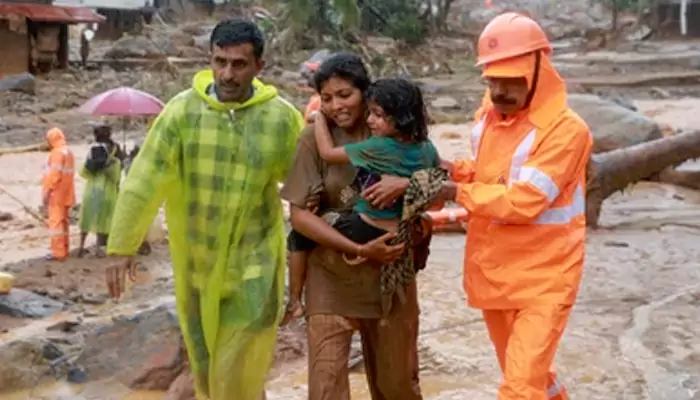Devastating Landslide in Kerala: Why God's Own Country is Prone to Nature's Extremes?
- Admin
- 1 year ago
- 4 minutes read

Within just four hours, three back-to-back landslides hit Kerala’s Wayanad creating havoc.
God's Own Country has suffered another huge blow due to devastating landslide claiming hundreds of lives, vanishing roads and villages. A minute of nature's fury can cause catastrophic results, and the vulnerable area of Kerala faced torrential rain of over 4 hours! Vehicles, shops, and even houses were swallowed by the earth leaving the whole landscape totally unrecognisable. Due to destruction of bridges, analysing full extent of disaster has become a challenge. NDRF along with other agencies are currently conducting rescue operations.
A landslide is defined as a “geological phenomenon” of “sudden movement of rock, earthen materials, and debris” down a sloped section of land. There are multiple reasons behind landslide including heavy rainfall, earthquakes, volcanic activity or even human activities such as deforestation, construction, and so on. Amidst rising risks, we will discuss the reasons behind Kerala's vulnerability to climatic disasters.

A Horrific Past:
This is not the first time Kerala is facing furious nature. During 1961 and 2016, nearly 300 people died due to landslides in Kerala. However, the frequency and intensity of such climatic events have increased drastically since 2018.
The state witnessed its worst floods in 2018, claiming 483 lives due to torrential rains. The annual rainfall count was overtaken by just 3 days of rainfall.
The monsoon seasons of 2019 and 2020 claimed over 100 lives. In 2021, floods and landslides in Kerala's Kottayam and Idukki districts also led to numerous fatalities. According to Indian Meteorological Department (IMD), 32 deaths were reported in 2022 due to rain-related incidents.
Tracing the Reasons:
Famous for its natural beauty, the southern peninsular state Kerala is sandwiched between mountain ranges of the Western Ghats and the Lakshadweep Sea. Kerala witnesses the highest number of devastating landslides in this country. Nearly 60% of total landslide events in India are reported from this state during 2015-2022.
#Heroism in Action : When the ground crumbles,true strength lifts us up.
— PRO Defence Kochi (@DefencePROkochi) July 30, 2024
Saluting the brave soldiers of #MadrasTerriers who carry hope on their backs.@CMOKerala appreciates the daring efforts of the Armed Forces in the rescue operations at #Wayanad.#WeCare#WayanadRescue pic.twitter.com/eRhi5bkUTv
(Credit - @DefencePROkochi X handle)
The only reason behind this catastrophic events is nothing but humans. Deforestation, climate change along with unplanned agriculture and construction activities are the major causes of landslide in Kerala.
Need to construction even in vulnerable as well as densely populated areas are exacerbating the condition. Kerala's geography is another factor behind excessive rainfall.
Was there any Warning for Climatic Disaster?
Shockingly, the answer is yes. Couple of months ago, researchers from the Indian Institute of Technology (IIT) Delhi published a “landslide susceptibility map.” This revealed around 60% landslide risk in Wayanad. Surprisingly, the areas (villages) devasted by the recent landslide were marked as “very high risk zone.”
Understanding the Risks:
The Kerala State Disaster Management Authority (KSDMA) has marked “1,848 square kilometers as High Landslide Hazard Zones.” At least 8% of the Western Ghats in Kerala is also marked as a “critical zone for mass movements.”
Beautiful Wayanad wears a picture of gloom 💔
— Nabila Jamal (@nabilajamal_) July 30, 2024
Death toll rises to 47
Hundreds suspected trapped in massive landslides that hit #Wayanad between 2am & 4am
Shelter camp set up at Bathery St Mary’s SKMJ School in Kalpetta with medical teams, ambulances, food & clothing provided.… pic.twitter.com/VNgVMcTaRd
(Credit - @nabilajamal_ X handle)
Except the coastal district Alappuzha, 13 districts of Kerala have been identified as “landslide-prone” by experts.
As per a recently published AI-supported research, nearly 13% of Kerala is “extremely prone” to landslides. The districts of Idukki, Palakkad, Malappuram, Pathanamthitta, and Wayanad were noted “highly vulnerable”. Shockingly, the 2018 rainfall and flood event increased 3.46% extreme landslide susceptibility zones, according to the study.
With such frequent catastrophic events, it's time to rethink about habitable options in vulnerable areas in Kerala.











.webp)
